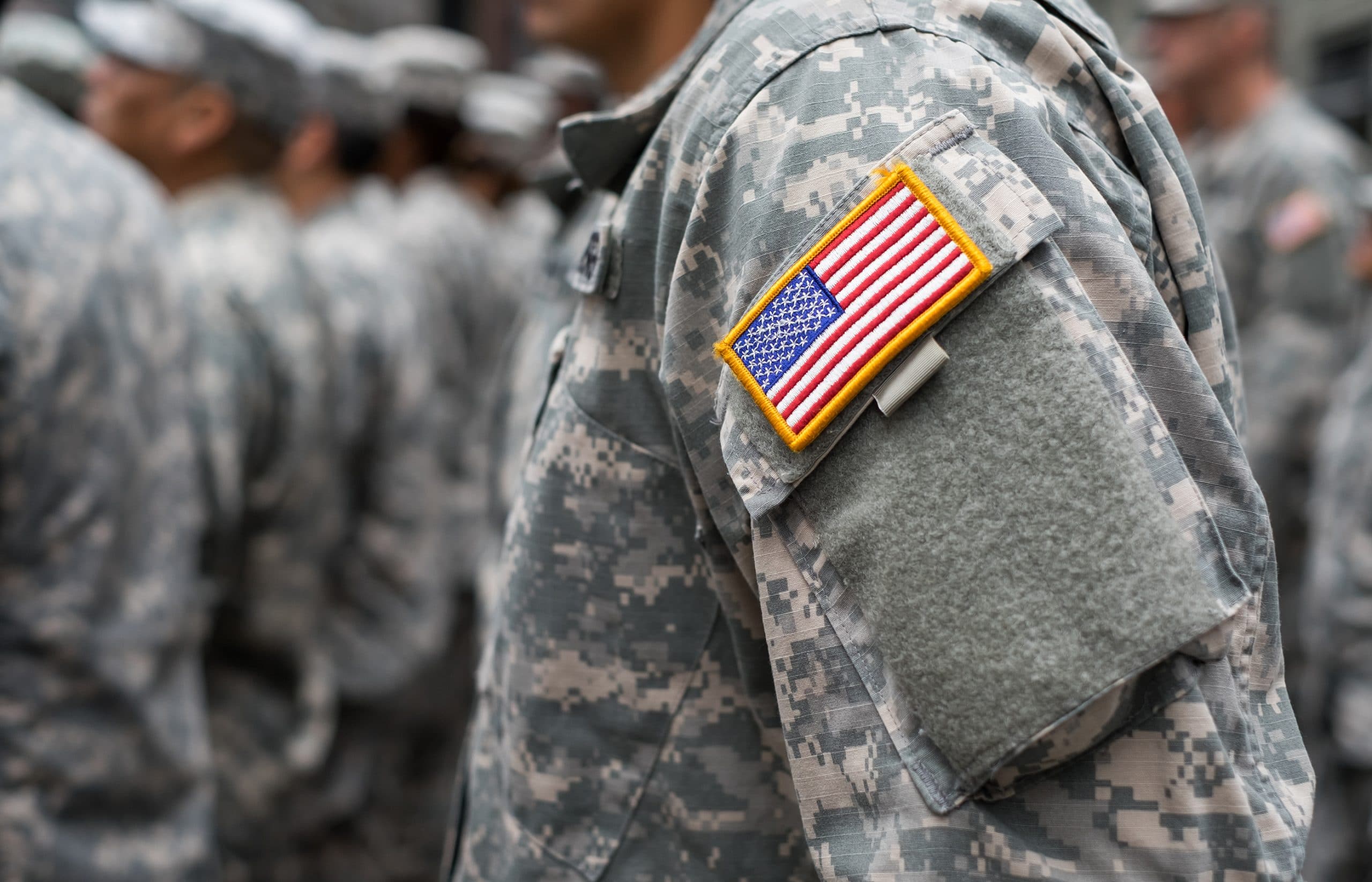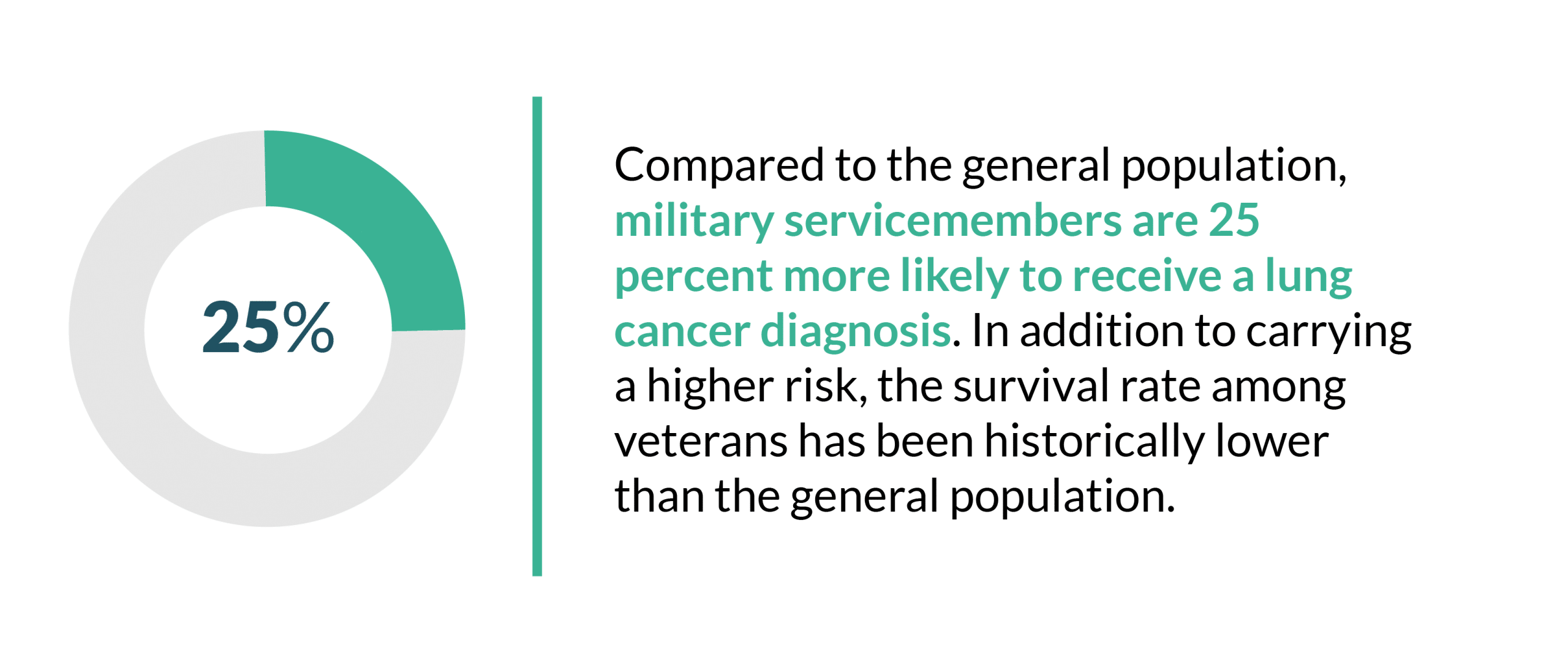Lung Cancer in the Military
For active duty military personnel, National Guard and Reserve servicemembers, veterans, and their families, the risk of lung cancer is higher than civilians.

Risk of Lung Cancer in the Military
Today, lung cancer is the leading cause of cancer death in the United States, making up over a quarter of all cancer-related deaths. For veterans of the U.S. military and other industries, the risk of being diagnosed with the disease is even higher. Compared to the general population, military service members are 25 percent more likely to receive a lung cancer diagnosis, with Coast Guard members being most at risk.
In addition to carrying a higher risk, the survival rate among veterans has been historically lower than the general population. The causes of lung cancer among military members are largely due to lifestyle habits like smoking and occupational exposure to pollutants.

In past years, studies of those affected by lung cancer have revealed statistically lower rates among active-duty military personnel versus their nonmilitary counterparts. Yet, 32 percent of active-duty servicemembers participate in high-risk activities like cigarette smoking compared to 20 percent of civilians. Among soldiers who’ve been deployed, smoking rates are 50 percent higher. Moreover, until 1976, soldiers were given free cigarettes in C and K rations.
However, current smokers make up only 20.9 percent of veterans with lung cancer and former smokers account for 60 percent. Approximately 17.9 percent never smoked and, subsequently, developed cancer via other causes.
Ask your doctor to review all possible treatment options. For more information on filing a legal claim, fill out a free case evaluation form.
Risk of Occupational Exposure
The risk of occupational exposure to carcinogens can be high depending on where the military servicemember is serving or has served in the past. Exposure to Agent Orange, asbestos, carbon monoxide in diesel exhaust, heavy smog, pesticides, oil well fires, and detonated or destroyed chemical weapons can lead to lung cancer.
Veterans of nearly every American conflict in the last century (including World War II, the Korean War, the Vietnam War, the Gulf War, and the wars in Iraq and Afghanistan) may have been exposed to cancer-causing particles in camps and overseas. Lung cancer, in particular, is a leading health concern among veterans due to the inhalation and ingestion of a spectrum of carcinogens.
One study of Gulf War veterans revealed that lung cancer was the only statistically significant cancer present among personnel (confirming its heightened risk over other cancers).
Military careers that may have put servicemembers at risk of hazardous exposure include those in industries such as:
- Automotive repair
- Longshore Workers
- Maritime and naval operations
- Petrochemical refinery careers
- Power plant and utility
- Railroad workers
- Steel and iron workers
- Tire and rubber worker manufacturers
Additionally, individuals may have been deployed to a high-risk area (such as locations with lots of open-air debris). Potentially unsafe and known cancer-causing substances include:
- Agent Orange
- Asbestos
- CARC (chemical agent resistant coating) paint
- Depleted uranium
- Infectious diseases of southwest Asia and Afghanistan
- Oil well fires
- Low-level nerve agents at Iraqi facilities
- Perchlorate (rocket fuel)
- PCBs (Polychlorinated biphenyl)
- Pesticides
- Radiation from nuclear weapons testing
- Sand, dust, particulates
- Solvents trichloroethylene (TCE) and perchloroethylene (PCE)
Military Benefits for Veterans With Cancer
The military health care system administers medical treatment and resources to more than 9.6 million people serving in one of the active armed forces, the National Guard and Reserves, retired veterans, as well as their families. The passage of several bills, starting in 2014, prompted major improvements to the health care program TRICARE and the Department of Veterans Affairs (VA).
While all servicemembers are able to submit claims for VA benefits, the coverage awarded to each individual varies depending on their rank, length of service, service-related injuries, type of discharge, and other military information.
Veterans of the following seven uniformed services (including National Guard and Reserve units) are available to receive TRICARE benefits:
- U.S. Army
- U.S. Air Force
- U.S. Navy
- U.S. Marine Corps
- U.S. Public Health Service
- Commissioned Corps of the National Oceanic and Atmospheric Administration
Today, government-provided health care has increased the lung cancer survival rate for its members; patients in this system now maintain higher survival rates than the general population. Researchers credit greater access to early screening methods (such as low-dose CT scans), a wider range of available treatment options, and advancements in curative therapies with the increase.
To see if you qualify for TRICARE health insurance or other VA benefits, visit TRICARE’s Eligibility page or Apply for Health Care Benefits on the VA’s website. You will need your Social Security number, a copy of your military discharge papers (i.e., the DD-214), your personal financial information, the most recent year’s tax return, and any current health insurance coverage information. Most applications for benefits are processed within a week.
Call the VA at 877-222-8387 for questions about your application.
For more information, fill out a free case evaluation form today.


